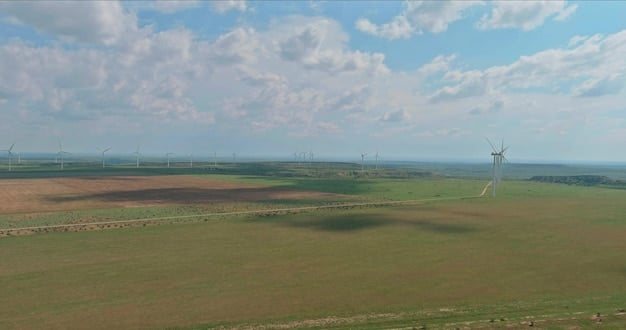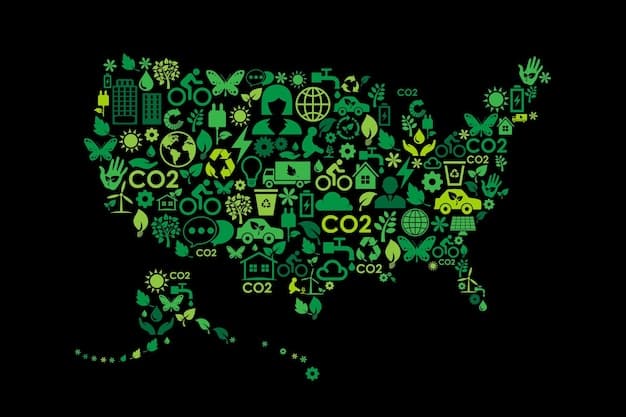US Paris Agreement Rejoin: 2025 Climate Policy Impact Assessment

The US rejoining the Paris Agreement significantly reshapes domestic climate policy, fostering renewed commitment to emission reduction targets, accelerating renewable energy deployment, and influencing state and local climate initiatives by 2025, amidst economic and technological shifts.
As 2025 unfolds, the decision regarding The Impact of the US Rejoining the Paris Agreement on Domestic Climate Policy: A 2025 Assessment continues to reverberate, reshaping the nation’s environmental landscape. This pivotal moment has ignited a comprehensive re-evaluation of strategies, investments, and collaborations aimed at tackling climate change within American borders.
The Renewed Framework: Setting the Stage for Domestic Action
The re-engagement with the Paris Agreement in 2025 marks a profound shift, signaling a renewed commitment to global climate action. This move is not merely symbolic; it establishes a reinforced framework that directly influences domestic climate policy. By participating again, the US reaffirms its intention to contribute to collective warming goals, which compels a more aggressive stance on internal policy directives.
A key aspect of this renewed framework is the immediate pressure to align national policies with the updated Nationally Determined Contributions (NDCs). These NDCs, once submitted, serve as a blueprint for domestic emissions reductions. The process involves identifying sectors for significant decarbonization and outlining specific targets, moving beyond aspirational goals to concrete, measurable commitments.
Reframing National Climate Targets
The first tangible impact is the reframing of national climate targets. Prior to rejoining, domestic efforts might have lacked the urgency or scale necessitated by international obligations. Now, there’s an imperative to accelerate decarbonization efforts across various sectors, from energy production to transportation and agriculture. This often translates into stricter regulations, increased incentives for green technologies, and a broader embrace of circular economy principles.
- Increased scrutiny on methane emissions from oil and gas operations.
- Accelerated timelines for transitioning federal vehicle fleets to electric.
- Expanded research and development funding for carbon capture technologies.
- New standards for energy efficiency in commercial and residential buildings.
The Paris Agreement’s structure, which includes regular reporting and a global stocktake, also introduces an element of accountability. While not legally binding in the traditional sense, the soft power of international pressure and peer review can influence domestic policy decisions. Governments are incentivized to demonstrate progress, fostering a competitive environment among nations to showcase their climate leadership.
Furthermore, rejoining strengthens the hand of domestic environmental agencies and advocates. It provides a clear mandate, legitimizing and bolstering efforts to implement ambitious climate policies. This can lead to more robust enforcement of existing regulations and the introduction of new legislative measures that might have faced greater resistance without international backing.
In essence, the 2025 framework is about integration. It’s about ensuring that domestic climate policy is not an isolated endeavor but an integral part of a larger, global effort to stabilize the climate. This interconnectedness encourages comprehensive planning and long-term vision, moving away from fragmented approaches to a more cohesive national strategy.
Economic Shifts and Green Innovation: A Catalyst for Growth
The re-engagement with the Paris Agreement isn’t just an environmental declaration; it’s a powerful economic accelerant. By 2025, we are observing significant economic shifts driven by a renewed focus on green innovation and sustainable development. Rejoining the agreement signals stability and long-term commitment, which are crucial for attracting investment in renewable energy and clean technologies.
This stability translates into increased investor confidence in the nascent green economy. Companies are more willing to pour capital into projects with clear policy signals, knowing that the regulatory environment supports their long-term growth. This is evident in the surge of venture capital and private equity flowing into sectors like battery storage, electric vehicle infrastructure, and advanced grid technologies.
Renewable Energy Expansion and Job Creation
One of the most immediate economic impacts is the rapid expansion of renewable energy sectors. Solar and wind power installations are experiencing unprecedented growth, not only due to declining costs but also because of supportive government policies. This expansion contributes directly to job creation, from manufacturing and installation to operations and maintenance.
- Significant increase in utility-scale solar and wind projects.
- Growth in domestic manufacturing of solar panels, wind turbine components, and battery cells.
- Expansion of skilled workforce training programs for green jobs.
- Increased investment in smart grid technologies to integrate renewables.
Beyond direct job creation, rejoining the agreement stimulates innovation across various industries. Companies are incentivized to develop more energy-efficient products, sustainable supply chains, and low-carbon production methods. This drive for innovation can enhance competitiveness in global markets, as consumer demand for sustainable goods and services continues to rise.
The financial sector is also adapting, with a growing emphasis on Environmental, Social, and Governance (ESG) criteria. Banks and investors are increasingly factoring climate risks and opportunities into their lending and investment decisions. This trend is amplified by the Paris Agreement’s renewed influence, pushing capital away from high-carbon industries towards more sustainable alternatives.

Moreover, the focus on climate mitigation can reduce long-term economic risks associated with extreme weather events and resource scarcity. By investing in adaptation and resilience measures, the nation can safeguard its infrastructure and reduce the economic burden of climate-related disasters. This proactive approach strengthens economic stability and fosters long-term prosperity.
In summary, the economic impact extends beyond direct investment in green technologies. It reshapes financial markets, encourages cross-sector innovation, and positions the US as a leader in the global green economy, driving sustainable growth and creating future-proof jobs.
Technological Advancement and Climate Solutions
The US rejoining the Paris Agreement in 2025 has significantly accelerated technological advancement in climate solutions. This renewed commitment has created a robust policy environment that favors investment in research, development, and deployment of cutting-edge technologies. The market signal is clear: low-carbon solutions are the future, prompting both established corporations and startups to innovate rapidly.
One of the most prominent areas of growth is in energy storage. As renewable energy sources like solar and wind become more prevalent, the need for efficient and scalable storage solutions intensifies. This has led to breakthroughs in battery technology, including solid-state batteries and flow batteries, alongside an increased focus on long-duration energy storage. The push for a stable, decarbonized grid is directly driving these innovations.
Driving Innovation in Carbon Capture and Utilization
Carbon capture, utilization, and storage (CCUS) technologies are also receiving unprecedented attention and funding. While still facing significant hurdles in terms of cost and scalability, the renewed policy emphasis provides a strong incentive for further development. This includes direct air capture (DAC) technologies, which actively remove carbon dioxide from the atmosphere, and efforts to utilize captured carbon in industrial processes.
- Development of more efficient and cost-effective DAC systems.
- Exploration of new materials for carbon absorption.
- Integration of CCUS with industrial emissions sources like steel and cement plants.
- Research into converting captured CO2 into valuable products like fuels or building materials.
Furthermore, advancements in digital technologies are playing a critical role in climate solutions. Artificial intelligence (AI) and machine learning (ML) are being used to optimize energy grids, predict extreme weather events, and improve the efficiency of industrial processes. Data analytics provides insights into energy consumption patterns, enabling smarter energy management and behavioral changes.
The agricultural sector is also seeing technological innovation aimed at reducing emissions and enhancing resilience. Precision agriculture, which uses data and sensors to optimize crop yields and reduce fertilizer use, is becoming more widespread. Developments in sustainable farming practices, such as no-till farming and cover cropping, are also being supported by policy and research efforts to sequester carbon in soil.
Building on these, advancements in sustainable transportation are transformative. Beyond electric vehicles, there’s growing investment in hydrogen fuel cell technology for heavy-duty transport, aviation, and shipping. The development of charging infrastructure, smart traffic management systems, and multimodal transit solutions are all part of this broader technological push encouraged by climate policy goals.
In essence, the technological landscape in 2025 is characterized by a rapid evolution of climate-centric solutions. The Paris Agreement’s renewed influence has created a fertile ground for innovation, pushing the boundaries of what is possible in decarbonization and resilience.
State and Local Initiatives: The Power of Subnational Action
Even before the US formally rejoined the Paris Agreement, many states and local governments were at the forefront of climate action, often defying national policy shifts. By 2025, with the federal government back at the table, these subnational initiatives are not only continuing but are being amplified and integrated into a more cohesive national strategy. This represents a powerful confluence of top-down and bottom-up efforts.
States like California, New York, and Massachusetts, which have long pursued ambitious climate goals, are now finding renewed federal partnerships and funding opportunities. This allows them to scale up existing programs, invest in new infrastructure, and pilot innovative climate solutions. Their leadership provides models and best practices for other states that are now feeling more emboldened to act.
Local Leadership in Decarbonization
At the local level, cities are becoming critical hubs for climate action. Many urban centers have committed to 100% renewable energy targets, implemented robust public transportation networks, and developed localized climate adaptation plans. Rejoining the Paris Agreement provides these cities with additional resources, expertise, and a sense of shared purpose within national objectives.
- Expansion of city-led green building codes and energy efficiency standards.
- Development of urban forestry programs and green infrastructure initiatives.
- Implementation of local clean energy procurement strategies.
- Increased funding for climate resilience projects in vulnerable communities.
The federal re-engagement also facilitates better coordination and resource sharing between different levels of government. For instance, federal agencies can now directly support state-level efforts to modernize energy grids, develop climate-smart agriculture programs, or invest in coastal resilience. This synergy is invaluable, helping to overcome some of the fragmentation that previously existed.
Furthermore, climate policies at state and local levels often serve as living laboratories for national policy. Successful programs piloted in a few states can be refined and then scaled up for broader adoption across the country. This iterative process allows for continuous learning and adaptation, ensuring that national policies are both effective and practical.
The emphasis on environmental justice at the federal level also resonates strongly with many state and local initiatives. Communities that have historically borne a disproportionate burden of pollution are now seeing increased attention and resources directed towards their needs, often through partnerships with local advocacy groups and community leaders. This ensures that the benefits of climate action are distributed equitably.

In essence, the rejoining of the Paris Agreement by 2025 has invigorated and unified climate action across all levels of government. It has fostered a more collaborative environment, empowering states and localities to continue their vital work while benefiting from renewed federal commitment and resources.
International Repercussions and US Global Leadership
The US rejoining the Paris Agreement by 2025 has profound international repercussions, fundamentally altering the dynamics of global climate action and re-establishing US leadership. This move has been met with widespread approval from allies and a renewed sense of optimism within the international climate community. The absence of the US had created a vacuum, and its return injects significant momentum and diplomatic weight into global efforts.
One of the immediate effects is the restoration of trust and credibility. When the US withdrew, it caused considerable apprehension and questioned the durability of global climate commitments. Its return signals reliability and a willingness to participate constructively, which is essential for fostering multilateral cooperation on complex issues like climate change.
Strengthened Diplomatic Engagement
The US is now more actively engaged in international climate negotiations, pushing for more ambitious targets and advocating for robust implementation mechanisms. This includes participation in high-level summits, bilateral discussions, and working groups focused on specific climate challenges, such as methane reductions or nature-based solutions.
- Increased US participation in international climate finance initiatives.
- Renewed diplomatic efforts to encourage other major emitters to strengthen their NDCs.
- Collaboration with developing nations on technology transfer and capacity building.
- Active role in shaping global standards and methodologies for emissions accounting.
Furthermore, the US return impacts climate finance. Developing countries, particularly those most vulnerable to climate impacts, rely on financial assistance from wealthier nations to fund their mitigation and adaptation efforts. The US, as a significant economic power, is expected to increase its contributions to funds like the Green Climate Fund, thereby enabling more climate projects globally.
The renewed emphasis on climate diplomacy also allows the US to exert influence on international trade and economic policies. There’s a growing discussion around carbon border adjustments and other measures that could incentivize countries to adopt more stringent climate policies. The US re-engagement positions it to shape these discussions rather than being on the sidelines.
Beyond formal diplomatic channels, the US rejoining fosters greater collaboration among scientists, researchers, and civil society organizations worldwide. Shared research initiatives, data sharing agreements, and joint advocacy campaigns can accelerate the pace of climate solutions and amplify pressure for stronger government action.
In essence, the international repercussions are overwhelmingly positive. The US by 2025 is not just a participant but a leader, leveraging its diplomatic influence, economic prowess, and technological innovation to drive global climate action forward. This renewed engagement is pivotal for the collective success of the Paris Agreement and the fight against climate change.
Challenges and Future Outlook: Navigating the Path Ahead
While the US rejoining the Paris Agreement has undeniably provided significant positive impetus to domestic climate policy by 2025, the path ahead is not without its challenges. Sustaining political will, integrating complex economic considerations, and adapting to unforeseen circumstances will be crucial for long-term success. The initial enthusiasm must be translated into durable, bipartisan policies.
One primary challenge lies in maintaining consistent policy direction across different political administrations. Climate policy often faces shifts depending on who holds power, leading to uncertainty for industries and investors. Building durable, widely supported climate frameworks that can withstand political transitions is paramount for achieving long-term goals.
Addressing Economic Disparities and Transition Costs
The transition to a low-carbon economy, while creating new opportunities, also presents economic disparities. Communities reliant on fossil fuel industries face job losses and economic displacement. Ensuring a just transition, which provides retraining, economic diversification, and social safety nets for these communities, is a complex but essential undertaking that requires careful planning and significant investment.
- Developing targeted retraining programs for workers in declining industries.
- Investing in economic development initiatives in fossil fuel-dependent regions.
- Ensuring equitable access to clean energy technologies and opportunities.
- Mitigating the impact of rising energy costs on vulnerable households.
Furthermore, technological innovation, while rapid, needs to scale at an unprecedented rate to meet ambitious climate targets. While breakthroughs are occurring, moving these technologies from laboratory to widespread commercial deployment requires vast capital, supportive infrastructure, and streamlined regulatory processes. The pace of this deployment will be a key determinant of success.
Beyond domestic challenges, external factors such as geopolitical instability, global economic downturns, or unforeseen climate events can impact policy implementation. The ability to adapt and remain resilient in the face of such external pressures will test the robustness of the domestic climate policy framework.
The future outlook, however, remains cautiously optimistic. The momentum generated by rejoining the agreement, coupled with technological advancements and growing public awareness, provides a strong foundation. The focus by 2025 is on solidifying these gains, transforming ambitious pledges into concrete, measurable outcomes, and ensuring that climate policy is deeply embedded across all sectors of the economy and society.
Sustained public engagement, collaborative efforts between government, industry, and civil society, and a commitment to continuous learning and adaptation will be vital in navigating these challenges and building a more resilient, sustainable future.
The Evolving Role of Public and Private Partnerships
By 2025, the US rejoining the Paris Agreement has significantly reshaped the landscape for public and private partnerships in climate action. The alignment of federal policy with global climate goals has created a more predictable and attractive environment for private sector investment, fostering unprecedented collaboration between government entities, corporations, and non-profit organizations. This synergy is proving essential for driving innovation and scaling solutions.
Federal agencies are increasingly engaging with the private sector through grants, tax incentives, and direct investments in clean energy infrastructure, research, and development. This goes beyond traditional grant-making to more integrated models where risks and rewards are shared, accelerating the deployment of new technologies that might otherwise struggle to find initial market traction.
Industry Leadership in Decarbonization Pathways
Leading corporations are setting ambitious decarbonization targets, often exceeding what is legally mandated. This is driven by investor pressure, consumer demand, and a recognition of the long-term economic opportunities in a green economy. These companies are investing in renewable energy, sustainable supply chains, and carbon reduction technologies, often in partnership with government and academia.
- Formation of industry consortia focused on developing low-carbon solutions for hard-to-abate sectors.
- Corporate procurement of 100% renewable energy for operations.
- Investment in green bonds and other sustainable finance instruments.
- Collaboration on carbon accounting and transparent reporting standards.
Non-profit organizations and academic institutions also play a crucial role, bridging the gap between policy, science, and practical implementation. They often facilitate dialogues, conduct research, develop pilot projects, and advocate for policy reforms. Their expertise is invaluable in ensuring that partnerships are equitable, effective, and community-centric.
These partnerships are not limited to large-scale initiatives. Local public-private collaborations are also flourishing, tackling issues like sustainable public transportation, community solar projects, and waste reduction programs. This localized approach ensures that climate solutions are tailored to specific community needs and contexts, fostering greater local ownership and engagement.
The growing emphasis on environmental justice within climate policy has also led to new models of partnership. These initiatives involve working directly with frontline communities to develop solutions that address historical environmental inequities while simultaneously promoting climate resilience. This ensures that the benefits of climate action are shared equitably and that vulnerable populations are not left behind.
In essence, the evolving role of public and private partnerships by 2025 is characterized by a mature recognition that climate action requires collective effort. The government provides the overarching framework and incentives, while the private sector brings innovation and capital, and non-profits ensure societal benefit and accountability. This collaborative model is fundamental to achieving ambitious climate goals.
Policy Integration and Holistic Approaches to Climate Governance
By 2025, a critical evolution in US domestic climate policy, hastened by the rejoining of the Paris Agreement, is the shift towards increasingly integrated and holistic approaches to climate governance. No longer are climate policies viewed in isolation; instead, there is a growing recognition that effective climate action must be embedded across all sectors of government and the economy.
This integration means that climate considerations are now influencing decisions in areas traditionally separate from environmental policy, such as infrastructure planning, public health, national security, and international trade. For instance, new infrastructure projects are increasingly evaluated not only for their economic viability but also for their carbon footprint and climate resilience.
Mainstreaming Climate in Government Operations
Federal agencies are adopting internal climate strategies, ensuring that their own operations, procurement, and investments align with national decarbonization goals. This includes everything from greening federal buildings and vehicle fleets to incorporating climate risk assessments into budgetary processes and long-term strategic planning. This mainstreaming sends a powerful signal to the private sector.
- Development of climate-informed guidelines for federal grants and loans.
- Integration of climate resilience into disaster preparedness and response planning.
- Emphasis on sustainable procurement practices across all government entities.
- Training programs for government employees on climate literacy and impact assessment.
The financial regulatory system is also beginning to integrate climate risk. Regulators are examining how climate change could impact the stability of financial markets, leading to new disclosure requirements for companies and stress tests for financial institutions. This ensures that economic decisions account for the physical and transitional risks associated with a changing climate.
Furthermore, there is a strong push for interagency coordination. Climate change is a cross-cutting issue, requiring seamless collaboration between departments of energy, agriculture, transportation, defense, and health. Standing task forces and shared data platforms are becoming more common, facilitating a unified government response to climate challenges.
This holistic approach also extends to research and development. Funding for climate science and technological innovation is becoming more coordinated, aiming to bridge gaps between basic research and commercial deployment. Multidisciplinary teams are tackling complex problems, recognizing that climate solutions often require expertise from diverse fields.
In essence, policy integration by 2025 means that climate action is not just an add-on but a fundamental lens through which governance is conducted. This comprehensive embedding across all levels and sectors of government is crucial for achieving the ambitious goals set forth under the renewed commitment to the Paris Agreement.
| Key Aspect | Brief Description |
|---|---|
| 🌎 Renewed Framework | Reaffirms commitment, sets clear NDCs, and increases domestic policy urgency by 2025. |
| 💡 Green Innovation | Drives investment in renewable energy, clean tech, and job creation across sectors. |
| 🤝 Subnational Action | States and cities amplify efforts, working in synergy with federal goals. |
| 🌍 Global Leadership | Restores US credibility, strengthens climate diplomacy, and boosts international collaboration. |
Frequently asked questions
▼
The primary impact is a significant acceleration and 강화 of domestic climate policy, driven by renewed national and international commitments. This includes setting more ambitious emissions reduction targets and implementing policies that prioritize renewable energy and sustainable development across all sectors.
▼
By 2025, rejoining stimulates significant economic shifts, fostering growth in green industries like solar, wind, and electric vehicles. It attracts investment to clean technologies, creates new jobs, and reorients financial markets towards sustainable practices, boosting overall economic resilience and global competitiveness.
▼
States and local governments amplify their existing climate initiatives, benefiting from renewed federal alignment, funding, and resources. They serve as critical implementation hubs for decarbonization efforts, often pioneering and scaling innovative solutions that can be adopted nationwide, fostering robust subnational action.
▼
Absolutely. Rejoining has significantly accelerated technological innovation by providing a clearer market signal and increased funding. This has led to rapid advancements in energy storage, carbon capture, sustainable agriculture, and smart grid technologies, essential for meeting climate goals and driving economic growth.
▼
Key challenges include maintaining consistent political will across administrations, ensuring a just transition for fossil fuel workers, and scaling technological advancements rapidly. Overcoming these requires sustained investment, bipartisan cooperation, and adaptive policy frameworks to achieve long-term decarbonization goals effectively.
Conclusion
By 2025, the overarching impact of the US rejoining the Paris Agreement on its domestic climate policy is unequivocally transformative. The shift has catalyzed a comprehensive re-evaluation of national priorities, embedding climate action deeper into economic, technological, and social frameworks. This renewed commitment has accelerated the transition to a cleaner energy economy, fostered green innovation, and strengthened both subnational initiatives and international collaboration. While challenges remain, the clear signal of long-term dedication has set the nation on a more robust and unified path toward achieving its climate objectives, signifying a pivotal moment in the global fight against climate change.





